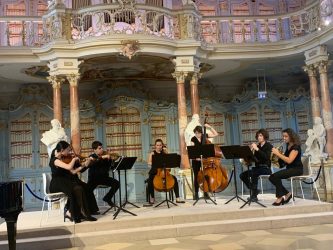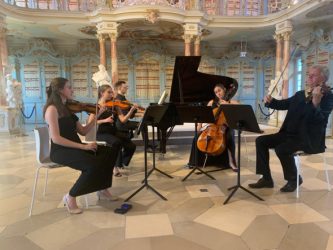 Germany Second International Chamber Music Academy at the Landesakademie in Ochsenhausen [1]: Faculty members Matthias Buchholz (viola) and Zora Slokar (horn), and students. Bibliothekssaal, Bad Schussenried, 14.7.2023. (LV)
Germany Second International Chamber Music Academy at the Landesakademie in Ochsenhausen [1]: Faculty members Matthias Buchholz (viola) and Zora Slokar (horn), and students. Bibliothekssaal, Bad Schussenried, 14.7.2023. (LV)

Beethoven – Piano Trio No.3 in C minor, Op.1 (first movement); Sextet in E-flat major, Op.81b (first movement)
Dvořák – String Quintet No.2 in G major, Op.77 (first movement)
Khachaturian – Trio for Clarinet, Violin and Piano
R. Schumann – Piano Quintet in E-flat major, Op.44 (first and second movements)
The first public concert of the Second International Chamber Music Academy at the Landesakademie in Ochsenhausen in partnership with the University of North Carolina School of the Arts, under the artistic direction of Ida Bieler, took place amidst the florid Baroque splendors of the Library at Schussenried Abbey, founded in the twelfth century. The concert featured fast and furious performances of famous (mostly) first movements by Beethoven, Dvořák and Schumann, played by students and two miraculous members of the faculty. In each of the performances, there were moments that made you wish they were playing the whole piece, and it was a complete work by Aram Khachaturian that stole the show.
The Armenian composer’s short Trio for Clarinet, Violin and Piano is not standard repertoire. Its deeply romantic heart, with its sensuous exotic tendrils, wove a seductive net of beauty, fashioned by clarinetist Seraphin Lutz, violinist Dylan Latham and pianist Sarah Core, that might have accompanied Scheherazade on her Arabian nights. Despite its unorthodox language, the three musicians kept the overall structure firmly in place and gave the music a surprisingly classical feel.
The middle Allegro was a rollicking, at times tipsy, affair, its luxuriant beauty adorned with pianist Core’s bejeweled magic, and the concluding Moderato felt like an extended riff on the previous movements. The wonderfully bass-rich, slightly over-bright hall provided the right Technicolor acoustic for Latham’s rhapsodizing and Lutz’s virtuosic eloquence, ending gently with a shepherd’s quiet piping.
The concert had begun with the surging strength, passion and pleasure of Beethoven’s Piano Trio No.3 which made clear how comprehensively the composer had taken over the piano trio legacy inherited from Haydn and Mozart. Luise Künzel’s dazzling piano complemented Clara Weigele’s elegant violin and Marcel Leczky’s powerful, impulsive cello. Together they brought to life the impetuous young Beethoven winning hearts and patrons in Vienna. Their understated return to the major key at the movement’s center paid dividends in creating anticipation and momentum leading to a brooding, fortissimo conclusion. One imagines that the young lion at the keyboard in 1795 might have improvised a cadenza at the last fermata, but it was not to be on Friday night in Schussenried.

Led by Matthias Buchholz, Schumann’s Piano Quintet Op.44 has rarely sounded so young and ardent. The Allegro brilliante verged on white-hot at times, but violinists Lydia Newton and Kali Bate kept order, and pianist Leander Brune never faltered in bringing poetry to Schumann’s massively difficult music. It was fun and instructive to see how the different bowings used by Buchholz and cellist Noey Gvili in the sweeping second theme were inspired by and reached the same urgent goal. The players took second movement at a slightly quick march speed, and the contrasting C major central section was sung so sweetly by Newton and Gvili, as if it were the composer’s serenade to his wife, that it brought tears to this critic’s eyes.
In the opening Allegro con brio of Beethoven’s difficult (for the two French horns) Sextet Op.81b, the horn players made the impossible possible, and the backing string quintet took the con brio very seriously. The opportunity to hear Swiss virtuoso Zora Slokar play this glorious tour de force, written at about the same time as the Piano Trio, in full galant style with its scales and arpeggios infused with poetry, was further enhanced by some astonishing acrobatics from Flynn Ewer, one of the Academy’s youngest members.
Meanwhile, cellist Ruth Stokes and double bassist Lacy Tier worked in tandem to provide a secure foundation for the infectious musical hijinks. Violinists Kryvie Tan and Julia Rabinalek, violist Bailey Rickman, Stokes and Tier were totally complicit with the two hornists at their enthusiastic speeds, and Slokar responded with a delicious, short cadenza towards the end.
Hearing even the first movement from Dvořák’s rarely performed String Quintet Op.77 for its unusual combination of string quartet and double-bass was an exciting prospect, and this performance made it hard to understand the neglect. Violinists Sebastian Leczky and Sophia Molina nailed all the key pivot points, while Simon Vazquez-Carr handsomely repaid the composer’s belief in the double bass. Together with violist Wynne Owre and cellist Itamar Gadol, they responded to the slightly dopey opening with rustic woodnotes and rambunctious energy in a performance intoxicated by the music’s succession of brilliant tunes. It made up in good-natured, headlong energy and moments of indescribable beauty what it lacked in finesse.
Laurence Vittes
